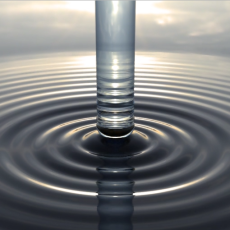Interface Dynamics
A myriad of problems in science and engineering require us to understand the interaction of multiple regions where geometries change over time. As these regions evolve, interfaces contort, break, and merge depending on a variety of factors, from local geometry to global properties transmitted instantaneously across the modeling domain. A familiar example is the dynamics of a soap bubble foam, where gaseous bubbles are separated by a network of interconnected thin films of liquid. As bubbles rearrange in a foam due to effects of surface tension, gas dynamics, permeability, etc., the network of interfaces evolves in time, changing shape and connectivity.
At Berkeley Lab, we are developing advanced mathematical frameworks and numerical algorithms for computing interface dynamics across a variety of applications, including industrial spray painting, semiconductor manufacturing, inkjet printing, wind turbines, shock tracking, combustion, and foamy materials in manufacturing.
We develop methods that are both mathematically and physically consistent; tackling these problems with enough accuracy to be useful requires some of the most advanced computational resources. To that end, part of our work is aimed at developing the mathematics behind higher-order accurate algorithms that naturally lend themselves to modern architectures, where attention to communication, data exchange, and computation throughput offer the opportunity for tremendous speedup.
Our methods in interface dynamics include level set methods, Voronoi implicit interface methods, interfacial gauge methods, implicit-mesh discontinuous Galerkin methods, and high-order quadrature schemes. We are also developing fundamental new advances in areas such as complex non-Newtonian multiphase fluid flow, high-order curvilinear meshing, and adaptive mesh refinement methods, as well as new algorithms for implementing these methods on systems at the Department of Energy’s scientific supercomputing facilities.
Projects
Algoim
Algoim is a collection of high-order accurate numerical methods and C++ algorithms for working with implicitly-defined geometry and level set methods. Contact: Robert Saye (Saye on the Web)
Voro++: A Three-dimensional Voronoi Library in C++
Voro++ is an open source software library for the computation of the Voronoi diagram is a widely-used tessellation that has applications in many scientific fields.
DistMesh
DistMesh is a simple MATLAB code for generating unstructured triangular and tetrahedral meshes.
News

New HPC4EI Project Aims to Cut Energy Costs of Painting Cars
Researchers from CRD's Mathematics Group are partnering with one of the world’s largest paint manufacturers on a new High Performance Computing for Energy Innovation project that aims to couple advanced mathematics with HPC resources to model the paint drying process and guide the development of new energy-efficient coatings systems for the automotive industry. Read More »

New Mathematics Accurately Captures Liquids and Surfaces Moving in Synergy
Berkeley Lab researchers in the Computing Sciences Division have developed a new mathematical framework that allows researchers to capture fluid dynamics at unprecedented detail. The work could be used in a range of applications, like optimizing the shape of a propeller blade and the ejection of ink droplets in printers. Read More »

Math of Popping Bubbles in a Foam
Researchers from the Department of Energy’s (DOE’s) Lawrence Berkeley National Laboratory (Berkeley Lab) and the University of California, Berkeley have described mathematically the successive stages in the complex evolution and disappearance of foamy bubbles, a feat that could help in modeling industrial processes in which liquids mix or in the formation of solid foams such as those used to cushion bicycle helmets. Read More »







 Instagram
Instagram YouTube
YouTube